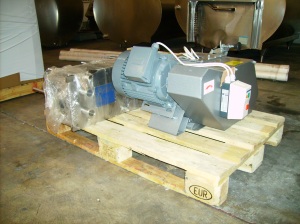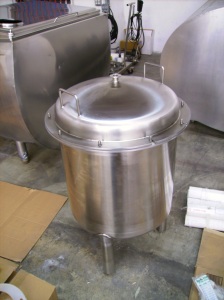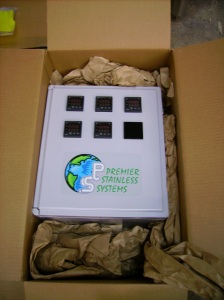Last week we made one more trip to San Diego to pickup another batch of equipment, this time from Premier Stainless Systems.
Among the new stuff was a bottling tank (also called a brite beer tank), a grain mill, grist case & grain auger, a heat exchanger, a temperature controller box (for controlling fermentation temperatures), some brewers hose, and a most excellent hop back!
Behold!
 Here’s our brite tank, still wrapped up and strapped to it’s shipping support frame. I think we’ll leave it on it’s side until we’re ready to install it though, since moving it around is much easier this way. This one has a 15 BBL capacity, and is jacketed for easy temperature control.
Here’s our brite tank, still wrapped up and strapped to it’s shipping support frame. I think we’ll leave it on it’s side until we’re ready to install it though, since moving it around is much easier this way. This one has a 15 BBL capacity, and is jacketed for easy temperature control.
Beer will be transferred into this tank where it will be prepared for bottling and also measured for tax purposes (tax is paid per barrel of beer produced).
 Here is our heat exchanger (left) and grain mill (right). These things are seriously heavy, so we’re also going to leave them on the pallet for now. The heat exchanger cools the wort quickly after the boil, so that yeast can be pitched and fermentation can begin. I know it’s obvious, but the grain mill crushes the malt and cracks the grain husks so that the starches inside can be accessible and converted to sugars during the mashing process. Grain will enter from the top into a small hopper (not shown here), get crushed by the metal rollers inside, then exit from the bottom of the mill, and drop into the grist case…
Here is our heat exchanger (left) and grain mill (right). These things are seriously heavy, so we’re also going to leave them on the pallet for now. The heat exchanger cools the wort quickly after the boil, so that yeast can be pitched and fermentation can begin. I know it’s obvious, but the grain mill crushes the malt and cracks the grain husks so that the starches inside can be accessible and converted to sugars during the mashing process. Grain will enter from the top into a small hopper (not shown here), get crushed by the metal rollers inside, then exit from the bottom of the mill, and drop into the grist case…
 The grist case (pictured on the left) will hold all of the crushed malt for an entire mash. Once all the malt has been milled, it will travel from the bottom cone of the grist case, into the auger, which will then carry it into the grist hydrator, and ultimately into the mash tun.
The grist case (pictured on the left) will hold all of the crushed malt for an entire mash. Once all the malt has been milled, it will travel from the bottom cone of the grist case, into the auger, which will then carry it into the grist hydrator, and ultimately into the mash tun.
Shiny…pretty…
If you’ve been on a tour of the Alesmith brewery lately, you’ve probably noticed a similar looking grist case that’s about 4 times bigger!
I didn’t take any photos of the grain auger yet, since it is disassembled and in several boxes, but the most visible parts of it look just like a bunch of PVC pipe. Actually that’s all it is. PVC pipe with a length of twisted metal inside (the actual auger), which is continually twisted by a motor. The twisting action carries the grain inside the PVC pipe from one end to the other. Not very exciting…
But here is something very exciting…our beautiful new hop back!
 We’ll be able to pack loads of hops into this baby, then pump the hot wort, straight out of the boil kettle and through those loads of hops. The hot wort will strip the aromatic oils from the hop cones, picking up some amazing aromas, then travel out the bottom of the hop back, and into the heat exchanger. I’m actually starting to drool right now as I think about it…
We’ll be able to pack loads of hops into this baby, then pump the hot wort, straight out of the boil kettle and through those loads of hops. The hot wort will strip the aromatic oils from the hop cones, picking up some amazing aromas, then travel out the bottom of the hop back, and into the heat exchanger. I’m actually starting to drool right now as I think about it…
Here’s a look inside at the screen that separates the hops from the wort. Basically this thing is like a gigantic colander, which makes it a very versatile and useful tool in the brewery. I figure we’ll use it for hops most of the time, but there’s really no limit to what we can do with this handy little piece of equipment.
I figure we’ll use it for hops most of the time, but there’s really no limit to what we can do with this handy little piece of equipment.
 Under the screen is a space for the wort to collect as it is separated from the hop solids, and then the wort exits through the port at the bottom.
Under the screen is a space for the wort to collect as it is separated from the hop solids, and then the wort exits through the port at the bottom.
I realize some of these photos are a bit fuzzy, so I apologize. What can I say…my camera is a quitter…
Last but not least, here is a shot of our temperature controller box. There are five individual controllers here (with a bunch of electronics inside), which connect to individual temperature probes on the fermentation, conditioning and bottling tanks.
 The controller box will also connect to our glycol chiller, so that when a cooling demand is needed at a tank, it will trigger a valve to open, sending more cold glycol into the jacket of that tank.
The controller box will also connect to our glycol chiller, so that when a cooling demand is needed at a tank, it will trigger a valve to open, sending more cold glycol into the jacket of that tank.
The guys at Premier have done a fantastic job for us, and now we have just about everything we need for a complete brewery. Now I’m more anxious than ever to hook everything up and start brewing!!






